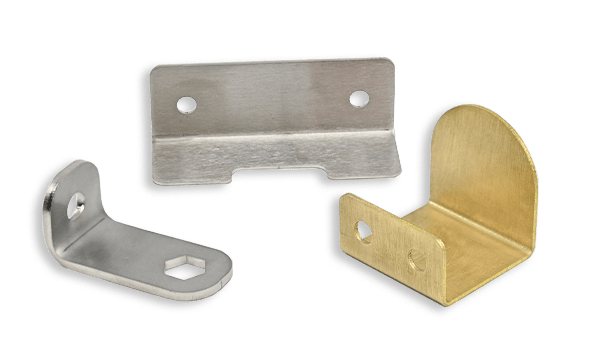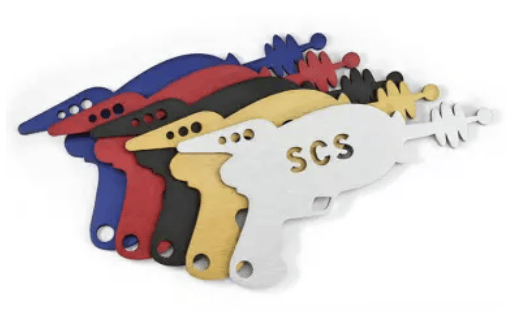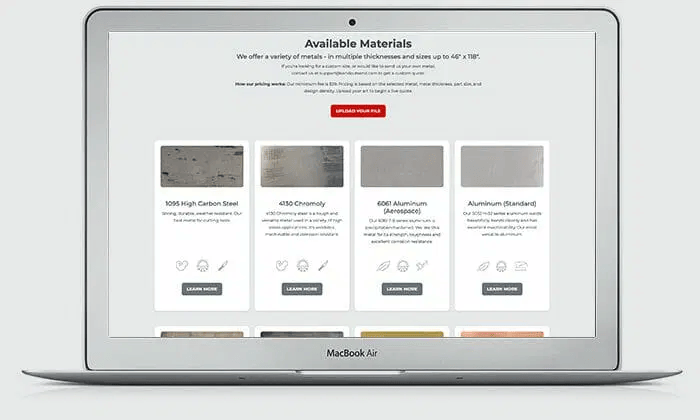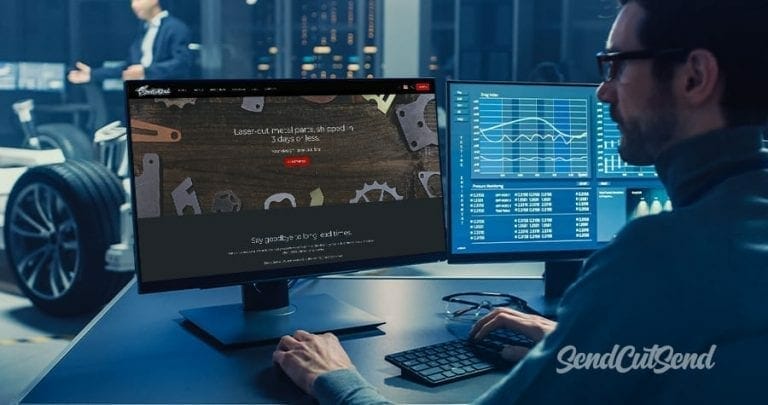Have you ever needed a unique metal part to complete a design project? Something you can’t find locally or online, where only a custom solution will work. What can you do? Where do you get that custom metal component you need to keep your project moving?
Why not make it yourself?
With online laser cutting services, like SendCutSend, you can turn your custom ideas into real metal parts delivered right to your door. The process is easy and fast and in this article we’ll walk you through the steps to make it happen.
Understanding Sheet Metal Fabrication in 8 Easy Steps: How Are Custom Sheet Metal Parts Made?
Let’s start by covering how metal parts get fabricated and what services are available. Understanding a little about the manufacturing processes can be especially useful when designing your parts to ensure they come out quickly and correctly. We’ll always review your designs in-house and choose the best tool for the job before anything gets cut, but you can read through our design guidelines to make sure your design is good to go.
1. Raw sheet metal for part fabrication is selected
Every custom part starts with the raw sheet of material. Sometimes that’s thin sheet metal, sometimes it’s thick plate. Thickness can impact cutting tolerances, but even our thickest materials can be cut precisely. Depending on the material, the appropriate machine to cut it is selected and your parts get cut.
2. Sheet metal goes through CNC cutting with the applicable cutting process
Laser Cutting – Many metals get cut using a fiber laser. This tool uses a high intensity focused beam of light to cut the material.
Waterjet Cutting – Waterjet cutting is another way of cutting shapes from flat materials. It creates a high pressure jet of water that typically carries a very fine abrasive to cut through even thick materials.
CNC Routing – A CNC router uses a traditional cutting tool, like an end mill. It spins the cutting tool in a spindle and guides the spindle through the material.
3. Parts that are finished with CNC cutting then get deburred
Parts can be chosen to be run through a deburring or tumbling process to remove burrs and sharp edges. This won’t remove all imperfections, but it does remove a lot.vTumbling removes burr from the cutting edge of your part and provides a smooth, soft feel.
5. If selected, metal parts then go through tapping & countersinking processes
Any holes that need threads cut into them are then tapped to accept threaded fasteners. For flat head fasteners that need to sit flush, you can also add countersinking to holes.
6. If needed, sheet metal parts then go through the bending & forming process

Did you know SendCutSend can bend your metal parts? That’s right, we can turn your flat parts into 3-dimensional shapes by adding bends. Flanges are created using a computer controlled press brake so bends are fast and accurate.
7. Sheet metal parts go through finishing services like anodizing, powder coating, or plating

You give your parts some extra protection or just a finished professional appearance, multiple finishing options are available. From zinc plating or anodizing to powder coating in a variety of colors.
8. If ordered, almost-finished sheet metal parts go through hardware insertion processes
Yep, we do that too. Sometimes a material is too thin to tap threads into or you need a different type of threaded fastener. Another option is to install threaded hardware such as nuts, standoffs and even threaded studs. This is a great way to make assembling your metal parts quick and easy. You can check out the hardware catalog to see what sizes are available.

Sheet Metal Options Available Online for Custom Metal Parts
There are a lot of metals to choose from, from decorative to durable. Let’s briefly go through them.
- 4130 Chromoly – Used to build roll cages in race cars, 4130 is a super strong high carbon steel.
- 6061 Aluminum – One of the most commonly used alloys of aluminum, 6061 is a good balance of strength and low cost.
- 5052 Aluminum – An excellent choice when bending aluminum is needed.
- 2024 Aluminum – Strong aluminum used a lot in aerospace for its fatigue resistance.
- 7075 Aluminum – The strongest aluminum we offer.
- AR400/AR500 – These two steels are known for their ability to resist abrasion. AR400/AR500 are used a lot in heavy digging equipment and gun targets.
- Brass – Beautiful and functional, brass is used as a bushing material for its self-lubricating properties, in electrical applications for its electrical conductivity and in decorative applications for its appearance.
- Mild Carbon Steel – An inexpensive workhorse material. Mild carbon steel is strong, bendable, weldable.
- Copper – Similar to brass, copper has excellent electrical conductivity. It is also used in heat sinks for its thermal conductivity (even better than aluminum) and in decorative applications.
- 304 and 316 Stainless Steel – Known for their excellent corrosion resistance. 304 and 316 stainless steel are a good option in marine environments where even coated mild steel will eventually rust.
- Grade 2 and 5 Titanium – The lightweight of aluminum, the strength of steel and the corrosion resistance of stainless. Used a lot in high end applications like aerospace and automotive racing.
- 1075 Spring Steel – Thin and springy! Used to make springs and light duty cutting edges.
- G90 Steel – A thin carbon steel with a hot-dipped galvanized coating for excellent corrosion resistance. Useful for forming enclosures.
For even more detailed information you can look up all the detailed properties and thicknesses available for each material in the materials pages.
How to Order Custom Sheet Metal Parts Online
We’ve covered the services and materials available for your custom metal parts, let’s step through the process of turning your idea into a delivered part.
Depending on your project, you will need to determine exactly what custom part you need to be produced.
One of the most valuable benefits of metal laser-cutting is you gain access to nearly unlimited potential in terms of what type of design you can turn into a tangible item. For example, you could develop a customized sign with your company’s logo, replacement parts for antique machines, customized BBQ grills, robot parts, welding tags, medical instruments, house or apartment numbers, and much more.

Once you’ve determined what item or individual part you want or need – transfer the concept into digital format by creating a file containing the design in the required size.
- Prepare and upload your design file

If you have a design and you’re ready to order custom metal parts online, upload your 2D vector file to your laser-cutting service of choice.
You can upload your design in the following formats for an immediate and automatic online quote: AI (Adobe Illustrator format), EPS, DWG, DXF, and STEP files for an automatic free quote. Make sure your file meets our design guidelines if at all possible so you can get instant pricing. Take a look at our export guides here!
As you prepare your file to send in for your order, keep in mind your artwork should be correctly scaled to the exact size you want it cut. Additionally, your file should only include an image of your design and not instructions, dimensions, scales, and borders. Check these design tips from SendCutSend experts and best practices for designing and laser cutting small parts.
For each file, include only one copy of what you want to be cut, whether your order quantity will be a single part or hundreds. You’ll specify your desired quantity during the ordering process. For higher quantities, there’s no need to nest multiples of the same part in a single file, we’ll take care of that for you.
If you don’t have the design tools (CAD or vector drawing software) to turn your idea into a 2D vector file, take a look at our in-house parts builder software. We also offer Design Services where you can send in a drawing or template and we’ll create your file and send you a cart for purchase.

Depending on your project and the part, you will need to choose the type of metal you want to use. With a service such as SendCutSend, you have access to numerous types of metals, from indestructible to malleable. During this step in the process, select your desired metal from a range of options.
Not only do you have choices about the type of metal, but you also can select your desired thickness for the part depending on its intended use.
- Talk over the specifics
After submitting your design file, we will contact you with any questions or concerns about your order. At this point, you’ll also get a precise price, taking into account exactly what you are looking for. Features that can affect the overall price of your order include the metal and its thickness along with the dimensions of your part and the design density. Intricate or detailed pieces take more time for the laser to cut, which impacts the overall price, too. Increasing quantities in your order can be a great way to significantly reduce the per part costs.
During this phase, you can also decide if you need other services, such as finishing and polishing, and choose to add these to your order. Then, once our manufacturing team has reviewed your file and clarified any issues, your order is sent to the laser for cutting.
- Delivery
Within a couple of days of finalizing your order, you can expect your parts to be shipped securely to your address – the average delivery time is 3 days. If you’re in a hurry to get your parts, you can select an overnight delivery option but it will increase your shipping costs.
When ordering parts in steel or copper which are thicker than .135”, there may be traces of oxidation on the cut surface, as oxygen is used as an assisting gas in the production process. You’ll need to use a chemical process or mechanical method to remove the oxidation before you paint, weld, or plate the parts.
Don’t Wait, Get Sheet Metal Parts When You Need Them
For many entrepreneurs, innovators, and manufacturers – time is money. Especially if you are working on a project that has a deadline or might impact your professional life, you can’t allow the need for a custom metal part to slow you down.
With all the services SendCutSend offers, our precision equipment and short lead times, you can get your custom metal parts made to the highest quality shipped quickly and securely straight to your door. Try out our parts builder or get a instant pricing for your own designs today!

